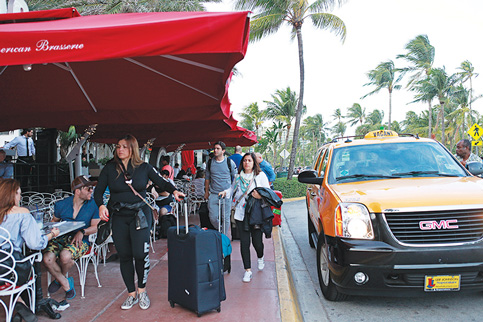Famed Ocean Drive might become Ocean Walk

Pedestrians first, bicyclists and transit second, personal vehicles last is the mantra for officials looking to revamp transportation in Miami Beach’s Entertainment District.
A permanently pedestrianized Ocean Drive was featured in a game plan that transportation staff presented at a city committee workshop last week.
The goal of such a makeover, Transportation Director Jose Gonzalez said, is to “activate the area in a positive way to promote economic development, while maintaining the essential functions of existing businesses as well as emergency vehicle access.”
The plan, Assistant Director Josiel Ferrer said, utilizes lessons the city learned from Covid-inspired initiatives such as adding protective bike lanes on Washington Avenue and focuses on priorities of the city’s 2016 Transportation Master Plan, which states that the priority for Washington Avenue should be transit, for Collins Avenue pedestrian/bicycle traffic and freight, and for Ocean Drive pedestrian traffic.
Short term, he said, Ocean Drive should remain closed to cars. Long term, he continued, it should be leveled to a single elevation with increased room for cafe seating and accessibility for emergency vehicles.
Interestingly, Mr. Ferrer said, data show that while 62% of Ocean Drive users are pedestrians, only 42% of the road’s space is intended for pedestrians, a ratio the new plan would remedy.
As personal cars would no longer be allowed, he said, delivery services and valet parking considerations would be addressed. Long term, this could include cul-de-sacs and valet-only zones at the ends of streets perpendicular to Ocean Drive.
Current findings, Mr. Ferrer said, indicate a pilot program that temporarily moved mass transit from Washington to Collins Avenue would fail long-term due to Collins’ congestion and limited rights-of-way. An immediate solution, he said, is to bring transit back to Washington and create “bus bays and transit platforms.” The longer-term goal for Washington, he said, is to redesign the entire corridor by reducing the median and adding transit-only lanes, bike lanes and on-street parking, potentially in the form of parklets that “bump out” from the main road.
For these long-term goals, he said, county approval is required.
On Collins, curb management services and freight loading zones are a short-term solution, while the potential increase in nearby garage space over the next three years could allow a greater transformation of the street to encourage multimodal transportation, Mr. Ferrer said.
On east-west streets that connect neighborhoods to the beach, encouraging safe connections is a top priority. Short term, he said, this can be done by painting bright green “sharrows” (share the road arrows) that show motorists that they share lanes with bikers. A future plan for these streets includes identifying a replacement for on-street parking and converting parking lanes into permanent, protected bike lanes.
Mr. Ferrer also recommended that the area’s designated delivery and loading zones have tiered permitting that allows only small two-axle vehicles in certain areas including Collins Avenue, while larger vehicles would only be permitted on the “200 block.” A second suggested was to limit delivery hours, for example from 7-11 a.m., after which freight lanes would become ride-share drop-off areas.







Recent Comments